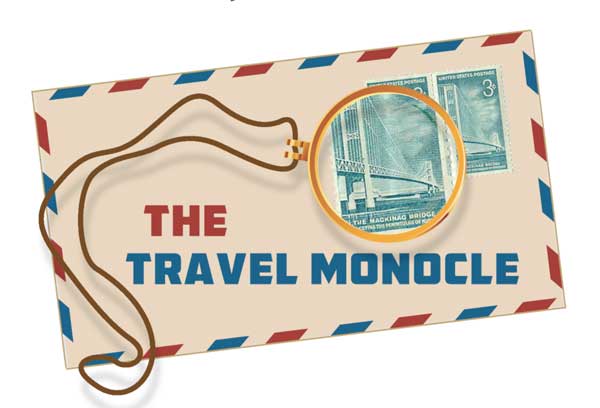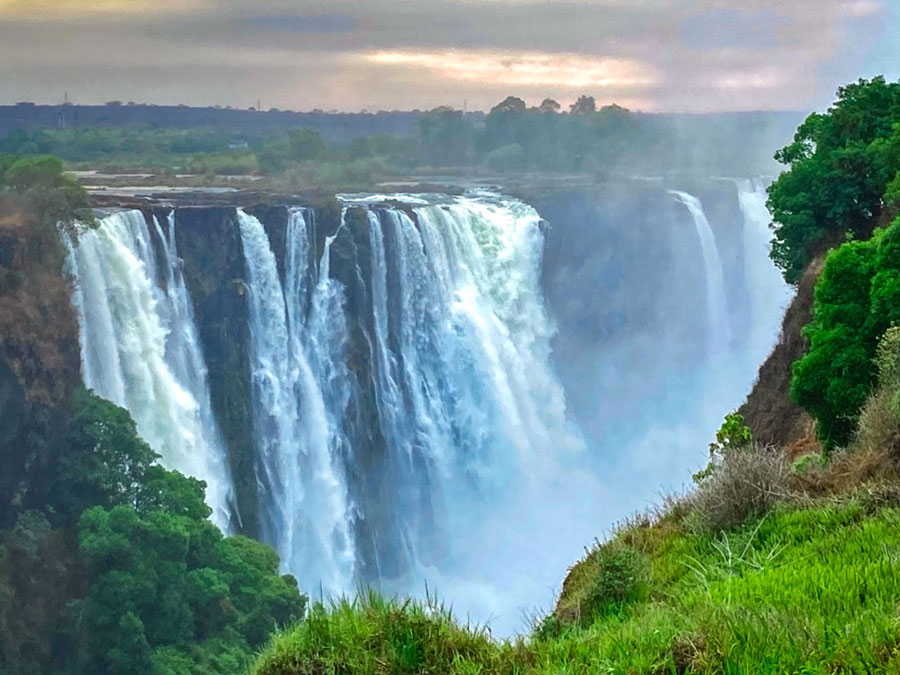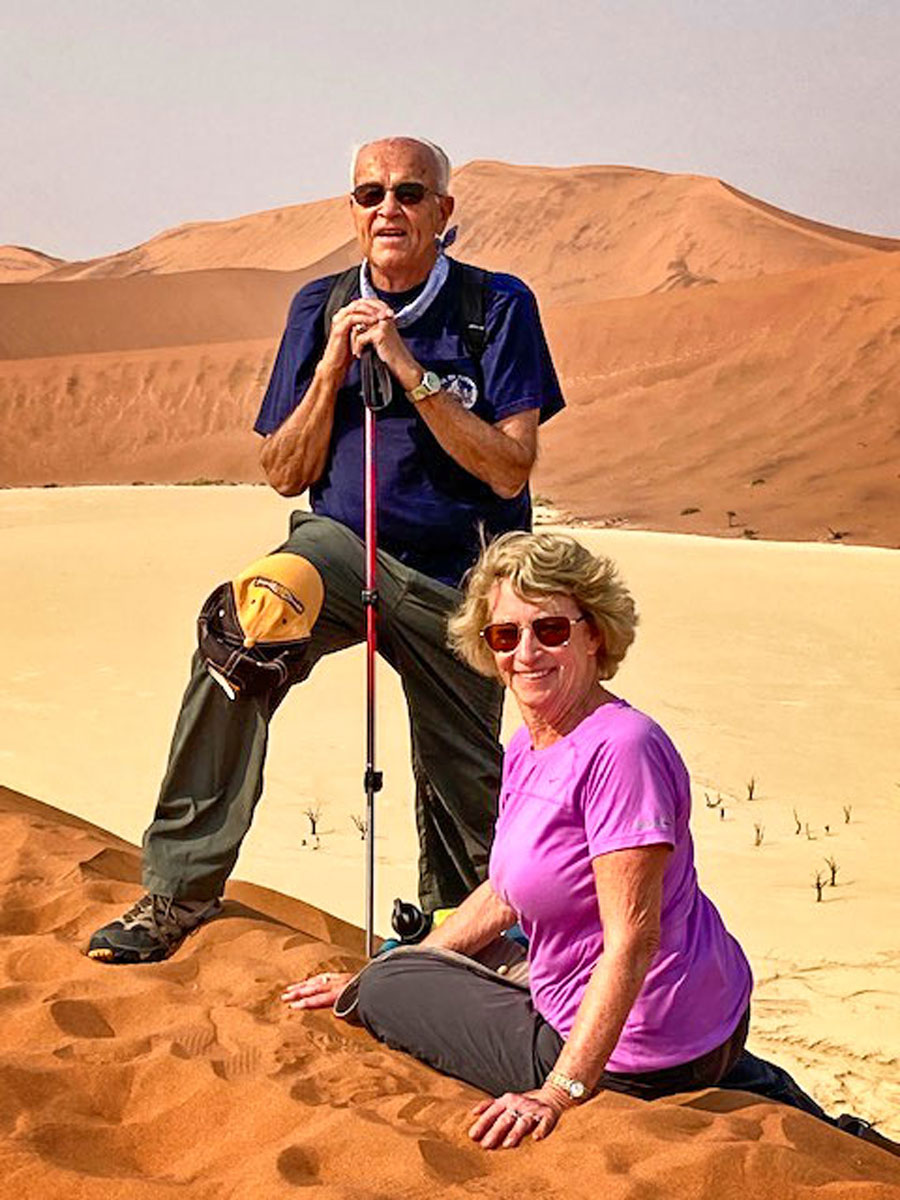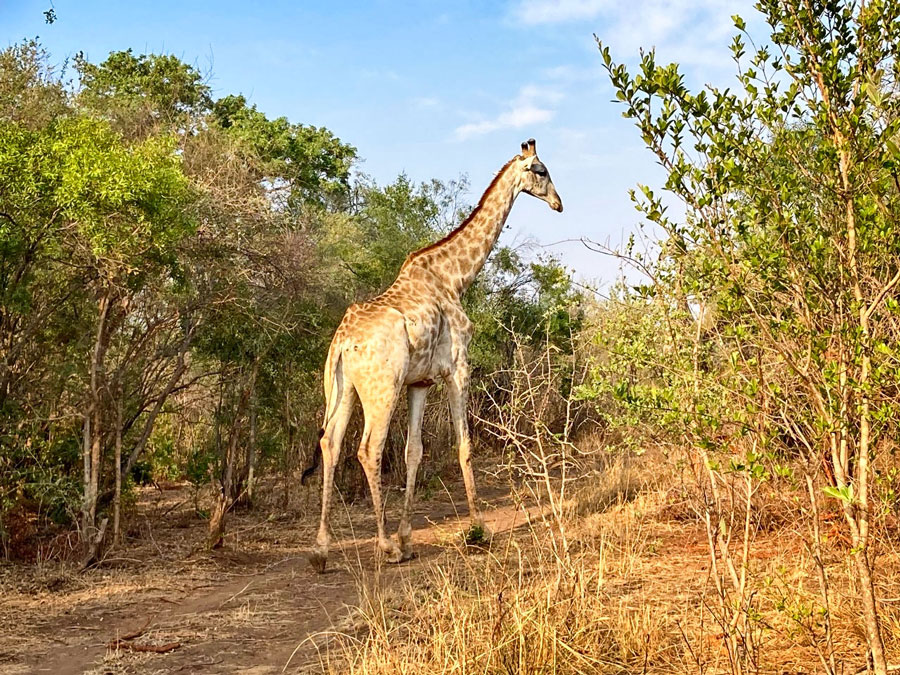Travel in Africa: A 40,000-Foot Perspective


Victoria Falls in Zimbabwe.
My wife and I have spent a total of four months in Africa over 30 years: Egypt, the Seychelles, the Republic of South Africa, Zimbabwe and Namibia. Our recent five-week trip was intense.
Visiting the continent requires heightened savvy and willingness to tolerate some creature discomforts. However, it was enriching beyond expectations, as exotic wildlife and wonders of the world await all who dare. Perhaps too, it was our last big “rodeo.”
A bit of history. When freed from the shackles of European colonization, newly independent countries were left in an economic condition varying with the nature and investments of its former European masters and the morality of those who seeped into the political power vacuums remaining. Though all are still classified as developing countries, some like Namibia inch slowly forward economically and with generally stable governments. Neighbor Zimbabwe is a bankrupt, failed state, the legacy of strongman Robert Mugabe.
Africa’s allure is all natural, the grace of her animals and physical beauty almost magnetic. Stunning visual wonders are plentiful: the Great Pyramids, the Nile, Congo and Zambezi rivers, Etosha Pan and Maasai Mara, Kalahari Desert and Fish River Canyon. She also controls 30% of the world’s minerals.
Her people are, by and large, decent and warm-hearted. Her shortcomings are also legion: poverty, shortage of quality infrastructure and corruption. Some years ago, there was a coup every 89 days. Safety issues cannot be overlooked.

Hiking the ridges of “Big Daddy” in the Sossusvlei.
Visiting Africa demands an open mind, a lust for adventure, and a willingness to leave civilization as you know it. It is not for the weak at heart. I see three options for planning a visit, if you are so inclined:
Tightly guided tours, as in shore excursions from a cruise ship. Safety and comfort factors are at a premium. You are cloaked in a learning atmosphere and exposed to the best facilities and transportation available.
High-end creature comfort route, primarily through wildlife and eco-sensitive tour packages. Adventurers progress from one upscale safari-type camp to another with prearranged transportation to popular tourist areas. An expansive breakfast is usually included, with gourmet meals available to include sunset buffets. Enriching, supplemental local side trips are offered by camp management.
Pure adventure. This is the self-guided method we chose – renting a vehicle, mapping our own itinerary, planning accommodations via the internet, and with enough money to buy our way out of trouble from unanticipated conditions. Due to the varying quality of infrastructure, accommodation quality, restaurants, language barriers and bathroom availability, one occasionally encounters dicey situations.
Naturally, the adventure option almost always appeals to the young who can live out of backpacks and sleep anywhere. Key to the method’s success is to be genuinely open and sensitive when connecting with locals. If you lack flexibility, it is a non-starter.

Many graceful giraffes and exotic wildlife.
Africa is not for most people. It is a rich continent with many poor people. The continent’s treasures mean little to its struggling, warm people whose lives of subsistence will be daily laid bare to you.
Go there in any format, eyes open wide. A successful journey guarantees awe and a newfound empathy for the full spectrum of human and animal conditions, vastly different from our own privileged lives. Some travelers even come away with a new perspective and a heart for the charities who seek to help Africa’s people.
Article and photos by Joe Gschwendtner
==================
Continued, part II:
Namibia and Zimbabwe: Africa on Display
To most, Africa has a foreboding travel profile: vast landscapes, untamed, exciting, beautiful animals and deadly creatures, and a painful colonial history. We found it all and more in our expansive October adventure.
All but 4 days were committed to Namibia. The reason: its broad palette of unusual attractions, architecture, infrastructure and the recommendations of two friends. A German colony (Southwest Africa) until World War I ended, there remain some 30,000 German-speaking citizens who are a significant part of its business fiber today.
To start, one must have time, and almost special driving talent and tolerance, as airline options are virtually non-existent. While road conditions vary, Namibia’s relatively minor traffic flows are still dangerous. Inexperienced drivers and mining trucks on roads represent serious safety threats. Unpaved roads also raise the risks for flat tires.
After spending a few days in the unremarkable capital city Windhoek, we drove southwest to hugely popular Sossusvlei, a saltpan bounded by towering sand dunes near Sesriem. Part of the massive Namib Sand Sea, generated by prevailing Atlantic winds, Sossusvlei’ s colors change vividly with the sun’s angle. It is a landscape like no other..
Climbing the dunes is another experience. We climbed “Big Daddy.” Below the dunes is the Dead Vlei, a dry lake caused by the isolation of the Tsauchab river bed by the blowing sands. Still-standing skeletons of ancient tree trunks are a photographers’ dream.
Further south is the world’s other “grand” canyon, formed by the Fish River. Huge, deep, dry and rivalling our own, one could spend days in the area. Hiking though is difficult, and the conditions challenging. We then followed the Orange River Valley, some of it a border with South Africa. We realized then at a zinc mine in Rosh Pinah, that valuable Namibian minerals were being excavated on a gargantuan scale and trans-shipped to China. This was a common theme throughout the country, including other minerals like uranium, lithium, copper, diamonds, and magnesium.
We visited coastal Luderitz, a city enveloped by sand and history. Swindled from natives by German merchant Adolph Luderitz in 1883, it became significant with the discovery of wind-blown diamonds in 1908. Nearby is the old sand-buried mining town of Kolmanskop. When the diamonds played out, it was abandoned, with the blowing sands reclaiming the land. Fascinating to explore….
Shark Island, a former internment camp held both native (Herero) prisoners and later, Germans themselves after World War I. Dias Point nearby, is marked with a cross where Portugal’s Bartolomeu Dias first touched Namibia’s coast in 1488.
Leaving the southern Atlantic coast, we encountered wild horses running free in the foothills. Near Keetmanshoop we visited a quiver tree forest and then “Giants’ Playground,” clustered natural stone formations.
Namibia’s second largest and also coastal city is Swakopmund. With great accommodations in the renovated railroad station, we enjoyed its many German restaurants, casino and theater. Swakopmund is also the country’s beach playground, sporting a long strand of sand and second homes. The cold South Atlantic Benguela Current offers Baltic Sea resort temperatures and can disappoint those craving sun and warmth.
Walvis Bay nearby is Namibia’s major port and center of its fishing industry. Vivid pink flamingo colonies pepper its salt pans. North of Swakopmund is Cape Cross and the Skeleton Coast. A massive seal Colony occupies the Cape as does a cross commemorating another Portuguese explorer’s (Diago Cao) visit in 1484. Though we needed no more evidence than one wreck, the treacherous, windswept coast claimed many floundering vessels and lives.
Namibia’s sweet spot for many is Etosha National Park, one of the greatest concentrations of wild animals on the continent. For a week, we freelanced it, visually intoxicated by dramas playing out everywhere. Kudu, springbok, oryx, zebra, giraffes, cheetah, lions elephant, wildebeest, rhinoceros: they all were on the playbill.
The highlight came at a watering hole. A lioness had just taken a giraffe down. Visibly panting, she sat 30 feet from the carcass, likely resting before a feast. Some of the giraffe’s friends showed up and made a scene. We imagined they were either chattering about the kill or simply mourning their friend. Wildebeest also paraded through, as did skittish zebras moving nervously back and forth. The vultures watched and waited for their plunder on a log.
Out of the bush came an elephant, blithely lumbering into the watering hole. He drank, frolicked and then went full submarine. Seemingly oblivious, he clearly lived in his own world, leaving as casually as he arrived. It was then we realized the lion is NOT the King of the jungle. The elephant is!
From Windhoek, we flew to Victoria Falls, Zimbabwe the ideal vantage point to view 1.7 kilometer-long Victoria Falls. Though with diminished flow in the dry season, we were not disappointed. It is, indeed, a wonder of the world. By helicopter and by foot, we absorbed her majesty from every perspective.
A final morning safari into a game reserve made for high adventure, where we encountered not one, but two rare black rhinos, one coming within 5 feet of my position in a safari wagon. Frankly, I was so mesmerized that I didn’t realize that proximity of the danger that stalked us.
We wrapped up the trip with Zambezi River dinner cruise, awed by many hippos, a few crocs, and elephants sauntering to the river for a drink. It was a fine way to end a rather remarkable trip.
Zimbabwe was both brilliant for what we saw, and equally tragic. A bankrupt nation, the sins of its despots laid bare in the dirt-poor poverty of her people stirs one’s soul. Though generous with our gratuities, we were otherwise powerless. Africa is that way, still exploited for treasures, mineral and animal. Tourism is its salvation for many….